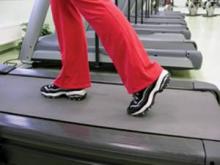Ninety minutes of aerobic exercise per week reduced depressive symptoms in patients with stable coronary heart disease to the same extent as did sertraline therapy, in a study of 101 patients published online Aug. 1 in the Journal of the American College of Cardiology.
In addition, the subgroup of 44 CHD patients who met the criteria for major depressive disorder were more likely to show remittance of their depressive symptoms after participating in an exercise program than were those who received either sertraline or placebo, said James A. Blumenthal, Ph.D., of the department of psychiatry and behavioral sciences at Duke University, Durham, N.C., and his associates.
At baseline, the study subjects underwent treadmill exercise testing to determine their aerobic capacity, as well as further psychological evaluation using the SCID (Structured Clinical Interview for Depression) and the HAM-D (Hamilton Rating Scale–Depression). They were stratified by age, CHD status, and depression severity, then randomly assigned to receive one of three interventions for 16 weeks: three 30-minute group exercise sessions per week (37 subjects), once-daily oral therapy with the SSRI sertraline (40 subjects), or once-daily use of a matching oral placebo (24 subjects).
In general, the study population was middle-aged (mean age, 64 years), white (73% of subjects), male (68% of subjects), married, relatively affluent, and well educated. In all, 44 subjects met the criteria for major depressive disorder, and the remainder had elevated depressive symptoms.
The primary end point was the HAM-D score at the end of the 4-month intervention.
All three study groups showed some improvements on this measure, but the two active interventions produced significantly greater reductions in HAM-D scores than did placebo. There was no significant difference in this improvement between exercise (a decline of 7.5 points) and sertraline therapy (a decline of 6.1 points), compared with placebo (a decline of 4.5 points).
In an intention-to-treat analysis, HAM-D scores were 3.3 points lower in the exercise group than in the placebo group, and 1.7 points lower in the sertraline group than in the placebo group, the investigators said (J. Am. Coll. Cardiol. 2012 Aug. 1 [doi:10.1016/j.jacc.2012.04.040]).
In the subgroup of patients with major depressive disorder, 6 of 15 (40%) in the exercise group remitted, compared with 2 of 20 (10%) in the sertraline group and 0 of 9 (0%) in the placebo group.
Sertraline was associated with more adverse effects than was exercise. Overall, 20% of the sertraline group reported worsening fatigue, compared with 2.4% of the exercise group and 8.8% of the placebo group. And 26% of the sertraline group reported increased sexual problems, compared with 2.4% of the exercise group and 11.8% of the placebo group.
These results are the first from a randomized clinical trial to show that exercise reduces depressive symptoms in stable CHD, which is particularly important "in light of the growing evidence that depression is associated with increased risk for fatal and nonfatal events in a wide range of CHD populations," Dr. Blumenthal and his colleagues said.
This study was supported by the National Heart, Lung, and Blood Institute and the National Center for Research Resources. Pfizer Pharmaceuticals provided the sertraline and matching placebo. Dr. Blumenthal did not report any financial conflicts of interest, but an associate reported ties to numerous industry sources.


